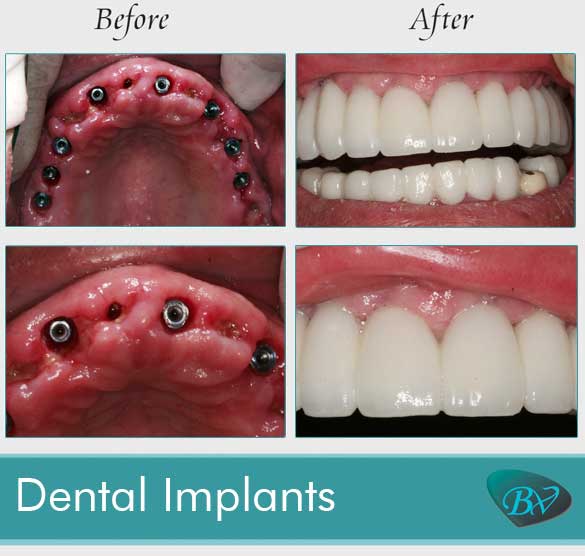More About Dental Sense
More About Dental Sense
Blog Article
The 3-Minute Rule for Dental Sense
Table of ContentsThe smart Trick of Dental Sense That Nobody is Talking AboutFascination About Dental SenseGetting My Dental Sense To WorkThe smart Trick of Dental Sense That Nobody is Talking About
are medical tools surgically implanted into the jaw to restore an individual's ability to chew or their appearance. They supply assistance for artificial (phony) teeth, such as crowns, bridges, or dentures. When a tooth is lost as a result of injury or illness, a person can experience difficulties such as rapid bone loss, defective speech, or modifications to eating patterns that result in pain.Dental dental implant systems consist of a dental implant body and dental implant joint and may additionally include an abutment addiction screw. Professional teeth whitening. The oral implant body is surgically put in the jawbone in location of the tooth's origin. The dental implant joint is normally attached to the dental implant body by the abutment fixation screw and expands with periodontals into the mouth to sustain the affixed man-made teeth
(https://myanimelist.net/profile/dentalsense1)Framework of The Oral Implant System selecting dental implants, speak with your oral service provider concerning the potential advantages and dangers, and whether you are a prospect for the treatment. Things to consider: Your general wellness is an important consider determining whether you are a good prospect for oral implants, just how long it will take to recover, and for how long the implant may remain in location.
Cigarette smoking might influence the recovery process and reduce the long-lasting success of the dental implant. The healing process for the implant body might take several months or longer, throughout which time you commonly have a short-lived abutment in area of the tooth. the dental implant procedure: Carefully follow the oral health instructions offered to you by your oral supplier.
Dental Sense Things To Know Before You Get This
Implant failure can result in the requirement for one more medical treatment to repair or change the implant system. Recovers the ability to eat Recovers aesthetic look Assists keep the jawbone from reducing as a result of bone loss Protects the wellness of the surrounding bone and periodontals Helps maintain adjacent (close-by) teeth stable Boosts high quality of life Damage to bordering all-natural teeth during implant positioning Injury to the surrounding cells during surgical treatment, such as sinus perforation Injury during surgical procedure (for instance, fracture of surrounding jawbone) Inadequate feature, such as seeming like the teeth do not bite together typically A sensation that the tooth hangs or turning in position arising from an abutment screw loosening up Implant body failing (looseness of the dental implant body) because of systemic infection, which may be most likely in clients with unchecked diabetes mellitus due to regional infection in bone and gums sustaining the implant body because of delayed healing, which may be more probable in people who smoke Trouble cleaning up the periodontals around the implant, resulting in poor oral health Unattended periodontal condition Post-surgical numbness as a result of nerve impingement or damages Constantly notify healthcare providers and imaging specialists that you have oral implants before any magnetic vibration imaging (MRI) or x-ray treatments.
FDA is not knowledgeable about any negative events reported for MRI or x-ray procedures with oral implants. Oral implants systems are usually made from products that comply with global consensus standards of the International Company for Standardization (ISO) or ASTM International. These requirements have information of what makes a safe product.

A dental implant is a structure that replaces a missing out on tooth. With screw-like devices, the cosmetic surgeon inserts a dental implant right into the jawbone, and it acts as a support for a synthetic tooth, called a crown.
Dental Sense Fundamentals Explained
Some people are not eligible for dental implant surgical treatment. It is for oral surgeons to operate on individuals with: intense illnessuncontrollable metabolic diseasebone or soft cells condition or infectionIf these concerns are dealt with, a person can have the surgery. In, dental specialists avoid running on individuals with: If people with any one of the above go through dental implant surgical treatment, there is a greater risk of the dental implant failing.

Oral dental implant surgery is a personalized procedure. It's not the same for everyone. The complying with offers a general review of what you can anticipate your dental practitioner, oral surgeon, periodontist or prosthodontist to check my site do: Position the implant operatively. Provide you time to heal. Attach the post and last crown, bridge or denture.
Next, your doctor will meticulously position the dental implant into your jaw. If your implant is near the front of your mouth, your dentist will make a short-term tooth for you to use till you recover.
Dental Sense for Dummies
Your supplier can tell you what to expect in your scenario. During the healing stage, your jawbone needs to fuse to the oral implant. This procedure, called osseointegration, is essential for stability and long-term success. This procedure can take anywhere from three to nine months. In many cases, it might take much longer.
Once your implant heals, your dentist can attach the abutment (little connector message) and your last restoration (crown, bridge or denture). This normally takes about one hour to finish and may need a second minor surgical treatment. You should not feel any kind of pain throughout your oral implant procedure because your provider will use medication to numb your periodontals.
Report this page